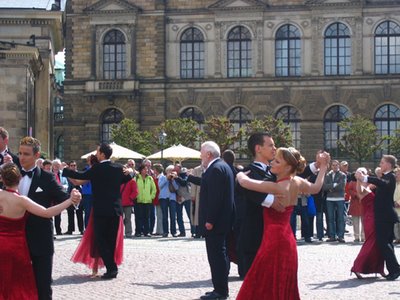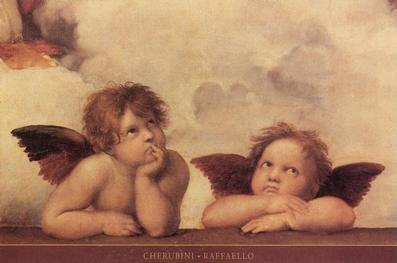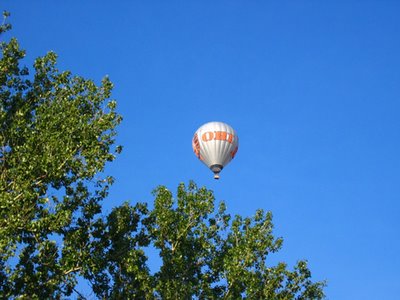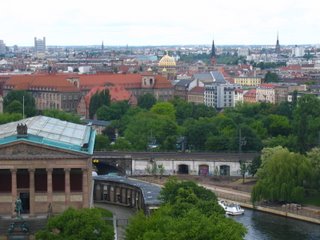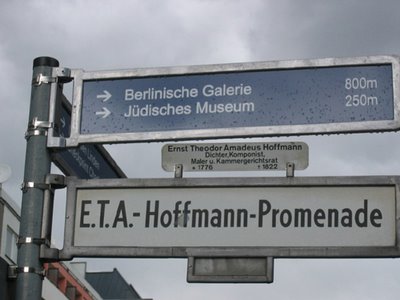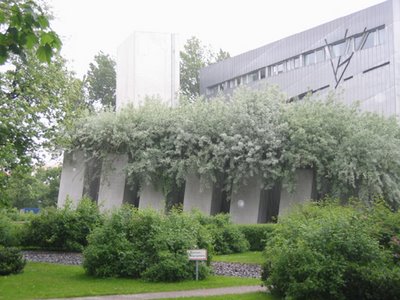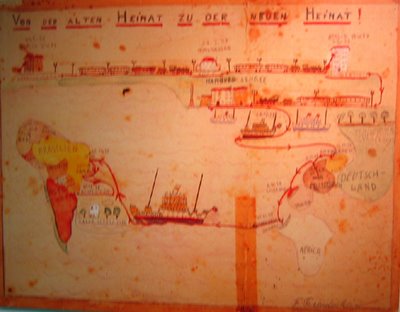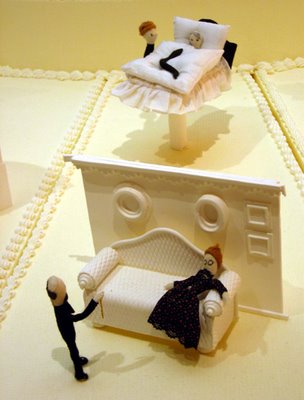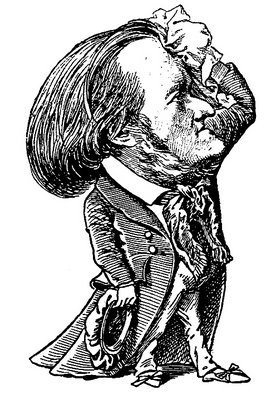‘Well, I’m back,’ he said. We made it. Copenhagen produced its first
Ring in almost a century. And we were there for the final performances; no one will ever see that particular
Ring ever again, since they’re planning on trashing the production and never remounting it. (The dramaturg tells me that since Wagner said, “Kinder, schafft neues” (Children, make something new) every time the
Ring is produced it ought to be different; and thus, if Denmark’s Kongelige Teater ever does another
Ring they’ll do everything differently next time. I don’t think they have any immediate plans to do it at all; my next
Ring will be the first-ever Canadian
Ring, in Toronto next September. (Maybe I’ll even blog it, if there’s popular demand.)
Ragnarok, as the Danes call the final opera, is quite a show. It’s my favorite of the four operas, because I feel it has the most stuff in it, as well as the most sophisticated music. Tonight’s production, like the rest of this particular
Ring, was full of interesting stuff but far from definitive.
The first line of
Götterdämmerung is sung by the First Norn: “Welch Licht leuchtet dort?” (What light is that?) It was fun, in the Copenhagen production, when she was sitting in the first row of the audience, stood up, tapped the conductor on the shoulder, and pointed to the maestro special light hanging from beneath the boxes. Fun—but really, kind of a waste, I take this moment as indicative of the basic issue I’m having with this
Ring (and which I suspect I’d be likely to have with many others: EFFECTS WITHOUT CAUSES. The phrase is Wagner’s, complaining about the Meyerbeer operas which were so much more popular than his, while he lived, and which are all but forgotten today. Splashy, superficial effects, zappy and fun though they may be—such as having the First Norn break down the 4th wall of theater, implicating the audience in the show—do not, in the end, an evening in the theater make. Or rather, they do, but we’ve witnessed a string of unrelated vaudeville acts jumbled together, not a great story thoughtfully told. Which—maybe I should have said this first thing—is what I want from a night in the theater.
The effect of that “Welch Licht leuchtet dort” moment is powerful. It acknowledges to the audience that we are there, that it is all about our experience—that we’re not watching a movie. It’s like when the storyteller looks you in the eyes, when the Ancient Mariner fixes you, o Wedding Guest, with his glittering eye. But the story-teller is supposed to be telling a story—there should be a cause behind the effect.
In fact, that line inquiring about the light is a great story-telling place to start; it relates to the basic theme of the opera, to the opera’s title.
Götterdämmerung, usually rendered in English
Twilight of the Gods, is even better translated as
God’s Gloaming, because the German word Dämmerung applies to both dawn and dusk—that time of mixed light, one going and one coming. The title of this opera doesn’t tell us which it is. Neither does the ambiguous ending of the story—was this a defeat or a triumph? What light is that? The answer, several lines later in the Norn scene, turns out to be ‘Loge’—the most ambiguous figure in the whole
Ring, the fire that serves and rebels, that protects and harms, Wagner’s greatest symbol of the modern age—a figure for technology, science, industry, skepticism, cynicism. What light is that? What is that light? It’s so much a part of the very fabric of our lives, today, everything most of us do, all day long, the Norn’s line is a great and very important question. Wagner gave us, in this moment, a worthy cause. So why can’t the effect stem from that source instead of this arbitrary conceit of the director?
That said, there was actually much I liked about yesterday’s
Götterdämmerung. The only thing I absolutely hated was the voice of the Hagen, who was about as great a singer as I am. (After the show I told Speight: “This performance makes hope blaze brightly in my bosom! As you know, it’s been my lifetime dream to sing Hagen, and if they hired that guy maybe someone will hire me!”) Just as
Rheingold stands or falls by its Loge, so a
Götterdämmerung sits on a tripod of Siegfried (Stig Anderson, wonderful), Brünnhilde (Tina Kiborg, less so) and Hagen (yesterday it was basically an actor who occasionally tried to hit a few notes). And since Hagen controls the plot—he’s the Iago, the cunning mastermind manipulator who plays all the other characters like puppets—it’s a serious thing when he gives an incomplete performance because he can’t sing. One of the things I love about going to hear
Götterdämmerung is the sound of a big, rich, dark, supremely evil bass voice, in scenes like the Watch Song or the Summoning of the Vassals, and in unforgettable lines like: “Hoiho! Wohin, du heitrer Held?” or “Heil, Siegfried! Theuer Held.” or “Meines Speeres Spitze wag’ ich daran: sie wahr’ in Ehren den Eid.” or “Meineid rächt’ ich!” When you don’t really hear or enjoy those, it’s only a partial
Götterdämmerung, says I.
I’m also sorry to say that despite the intentions of director and dramaturg, there really is no concept to this
Ring. They called it “Brünnhilde’s Ring” in their publications on the subject; we’d taken to calling it the feminist or matriarchal
Ring because of the way it was pitched initially, which implied that their point was: men are unfit to rule the world and run things because their narcissistic, aggressive, short-sighted ways make a mess of everything; and furthermore, in the new world order of the new millenium, it’s the girls (the made-wise-by-experience Brünnhilde, for example) who will be doing a better job of running things. All I can say is: maybe so. But a) I’m not sure that’s what the
Ring is about; sounds to me like a case of square peg and round hole, an artistic team who want to say what they have to say regardless of what the piece is about; and b) if that in fact is what they were trying to say, they did a poor job of saying it!
The only ‘feminist’ or ‘strong woman’ features of this
Götterdämmerung, that I recall, include Brünnhilde coming in with a gun when Hagen tries to take the ring, after he’s killed Gunther. Ordinarily Siegfried’s dead hand rises up at this point, greeting Brünnhilde’s entrance as per the prophetic words with which he died. (It may be this is not one of Wagner’s strongest moments; it’s often perplexed stage directors, since it seems an example of a Wagnerian effect with no cause, or at least a dubious one. The other example of this kind of thing would be the Norns’ rope breaking, to end the first scene.) Our director in Copenhagen had Hagen shoot Gunther, advance towards the dead Siegfried with his gun, and Brünnhilde enter from the other side of the dead Siegfried, her own gun pointed at Hagen. Hagen makes a little gesture of “Uh-oh! She’s got a gun,” and for some reason he drops his on a nearby couch and slinks away so she can sing her immolation scene. It didn’t make any sense to me—as a plot point, it wasn’t even the story of Brünnhilde’s weapon being more powerful than Hagen’s. (Which, had that been the story they were trying to tell, could hardly be considered productively feminist!)
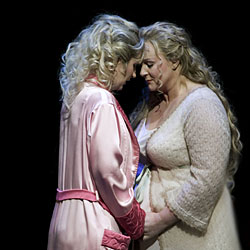
The other ‘strong woman’ moment comes a few lines later, when Brünnhilde forgives Gutrune and the two share a warm embrace. (See picture.) Whatever. Wagner leaves Gutrune’s fate ambiguous; directors who hate such loose ends always feel a need to finish her story. Since the world is about to be destroyed, it’s never mattered much to me what happens to her. I wasn’t sure, in this production, this Gutrune was deserving of forgiveness...she was a pretty bad lot.
I want to describe some of the things I liked about the Copenhagen
Götterdämmerung. (Sorry to be so crabby thus far!) I loved such elements as:
 Light-hearted Norn Scene
Light-hearted Norn Scene. I know many who found it sacreligious, but something about the fun this production had in the Norn scene appealed to me. This scene contains some of the greatest music Wagner ever wrote, but typically it’s hard to make it interesting or dangerous in performance, since there’s something undramatic about watching three old biddies gossip and spin threads and tales for twenty minutes. And it’s only great music if you understand the text; without the words, I doubt it makes a heck of a lot of sense. As I mentioned, the Norns were in the audience for their first three speeches (Wotan’s past, present, and future); they appear onstage for their second round of speeches (Loge’s past, present, and future) and their triple rejoinders about Alberich—then, when they sing “Es ris! Es ris! Es ris!” (where the web of fate traditionally breaks, for obscure reasons) the curtain goes up to reveal the set for the next scene. The staging didn’t have much to do with the specifics of the stories they were telling—but it was engaging and structurally interesting.
 Houseplants chez Brünnhilde
Houseplants chez Brünnhilde. After a week of complaining, in this blog, about the ugly Valkyrie Rock with its artificial forms of manufacture, I was pleased to see that somebody must have been reading me—in the first act, that set was now a greenhouse, with plants all over the little room where Siegfried and Brünnhilde have been living. That’s all I wanted...natural shapes, the chaos and proliferation of a vine hanging from the walls and ceiling, tails of white flowers hanging from it like fuschia, and lots more plants everywhere else. Makes me want to go live in a jungle!
Stig and Tina. Setting the voices aside for a moment, Stig Anderson and Tina Kiborg make far and away the strongest VISUAL Siegfried and Brünnhilde I’ve ever seen. They’re both impassioned actors, warmly giving of themselves onstage; they both hurl themselves into these roles; they’re both beautiful, and (being Danish) look kind of like you think Siegfried and Brünnhilde probably looked; and, being husband and wife, there’s a terrific chemistry between them which they bring onto the stage. Now, I’ve already noted that I don’t think Kiborg really has the appropriate Brünnhilde voice. Anderson, on the other hand, sang it very well—perhaps not the best I’ve ever heard, but beautiful, nuanced, interesting, and (except in the parts that no one can sing) accurate.
Gunther as Modern Warlord. As this
Ring kept advancing through the twentieth century, we end with
Götterdämmerung set in the late 90’s or maybe 2000, with (Guido Paevatalu as) King Gunther of the Gibichungs seen as leader of a private army, possibly in the war-ridden Balkans. He might have ruled someplace in the mideast, or Africa, but the cityscape looked sort of European. Anyways, the characterization was great—his degeneracy and basic uselessness reminded me of plenty of spoiled Eastern Europeans I have known.
Psycho Hagen. I thought this Hagen was a non-singing actor because he acted the part so well. We first saw him in
Siegfried Act Two, where he’s made up to look like a college boy; in this opera he’s older, an albino-mole person like his father and uncle (since Nibelungs live underground?) who resembles Peter Cushing as Grand Moff Tarkin in
Star Wars (and at the same time Principal Seymour Skinner, if he were a real person). He has an obsession with shooting and killing people, which we noticed in
Siegfried Act Two as he was constantly pointing his fingers like a gun at his father, or at Siegfried, to indicate how he wished to shoot them. In addition to stabbing Siegfried with his bayonet and shooting Gunther (both of whom Wagner asks him to murder), Hagen stabs Alberich in the belly with a pocket-knife (Alberich continues to sing, “Sei treu, treu...treu” after the fact, which made the moment of stabbing seem kind of arbitrary), murders a bunch of prisoners captured by Gunther’s army, and finally exits the stage (after “Züruck vom Ring!”) with his right arm on fire—remember, his father lost his right arm—after reaching into the flaming Valhalla library trying to retrieve the ring. Peter Kazaras, you’re not the only one whose arm can light up in
Götterdämmerung!
Scuzbucket Gutrune. I liked Yiva Kihlberg, who played Gutrune as a trashy sexpot, engaged at their first entrance in an amorous scene with her brother. While I’ve often speculated on just what the real deal is with those Gibichungs, and I think it’s possible that the thought crossed Wagner’s mind that Gunther and Gutrune were up to something, I can report—now having seen it—that it really doesn’t add anything to the show. Unless you kept returning to the idea, in scene after scene, you quickly forget about their incest after Siegfried arrives. So what’s the point of playing it up? It only makes unsympathetic characters even more repulsive.
 Drink as drugs
Drink as drugs. The magic potion can be a tough plot point, in
Götterdämmerung, but I honestly think it’s great. It makes perfect sense, in a production like this one, where they give him lots and lots of alcohol, laced with some unindentified drug, and Siegfried immediately becomes a different person—as people do who are addicted to drugs.
The reverse Rhine journey. The orchestra played the reverse Rhine journey very nicely, I’m happy to report. I was dreading it, ‘cause usually it’s a very dull piece indeed—all about Hagen’s inner emptiness and Brünnhilde’s loneliness, which she can’t understand. But I think it was their best playing of the evening.
Waltraute. Again, we were all surprised and delighted by Annette Bud, the really great Waltraute. There wasn’t anything unusual about the staging of her scene, but she did a fine job of singing and acting it—and that’s not always the case.
Real Vassals. The nice thing about a contemporary, updated production is that it forces everyone to think of the characters are real people. Sometimes, when they look really far out, you go into a weird mental state where you know you’re supposed to be suspending disbelief, but you aren’t, really; yet you think you are. When the Gibichung Vassals come out dressed in outrageous quasi-medieval costumes, and stand in semi-circles like your standard nineteenth-century opera chorus, it’s easy for the audience to stop living the show as drama. In this case, with them Slobodan Milosevic’s private army of terrorist thugs, they were all too real to all of us.
Staging of Act Two Quintet. You’re probably thinking “Wait, there’s no quintet, there’s a trio! The man must be mad!” And no, the trio was no good at all (none of them were good singers, which you need if you’re going to do that piece). I’m talking about one of the hardest scenes in all drama to stage sensibly, the five-person pentagle earlier in the second act, the double wedding of Brünnhilde, Gunther, Gutrune, and Siegfried, assisted by Hagen. Only once before have I seen that scene make any sense at all, in terms of the drama—who knows what, who’s thinking what, and who wants what from who. It’s very obscure in the text, probably on purpose, but always a danger spot in the theater—here negotiated with great success.
 Old Rhinedaughters.
Old Rhinedaughters. Siegfried dreams of the Rhinedaughters at the top of Act Three. (Don’t ask me why it was a dream. Makes no difference to the plot one way or the other.) They, at first, are still wearing their 1920s costumes and wigs, but when they dive under the Rhine and resurface they now look like hideous old hags—much like how the Norns usually look. I thought this was fascinating, although what bearing it has on a matriarchal/feminist interpretation is beyond me.
Death of Siegfried. Stig Anderson’s rendering of the death scene, with the narration before it and the vision after he’s stabbed—sung, in this case, directly to Brünnhilde, was musically the climax of the week.
Singing “Ruhe” to Wotan #4. This director annoyed me many times by bringing on characters who aren’t supposed to be in those scenes and not giving them anything significant to do; two exceptions are the appearance of Brünnhilde in Siegfried’s death scene just mentioned, and the appearance of Wotan during the Immolation—a Wotan double (that’s the fourth Wotan we’ve seen this week! I’m going crazy!), looking very old, sitting in a chair and facing upstage, interacts with Brünnhilde during the part of the Immolation where she’s addressing him. A very nice idea.
 Video Projections.
Video Projections. In the final act we had a huge screen illuminated by rear projectors at the back of the stage; twice a phalanx of airplanes flew toward us from the distance and soared over Brünnhilde’s head; and then, when she set everything on fire, we saw a fire burning on the screen. Okay...so the use of projection in this case was a little basic. But I think it offers lots of possibilities for future
Ring directors...think, guys, think...
 Baby
Baby. Brünnhilde was pregnant all through
Götterdämmerung, and runs offstage after “Selig grüß dich dein Weib!” to have her baby—she then returns, holding it, for the final motif, which refers to her self-sacrificial love. John Nesholm had predicted this before we even arrived at the theater, and when he said it, I remember saying: “Oh, please, no, what a cliché, how obvious.” Yes; and yet, when I saw it, and heard that music, I had a little emotional moment. It’s probably the old theater adage—nothing is as guaranteed irresistible as a baby (so don’t share the stage with them!). A physical reaction kicks in, and we all go: Aww... Which is perfect for that music. So, yes, it was cheap—but effective. In this case, an effect with a cause so deep that I’ll allow it. Just don’t anybody else try it!

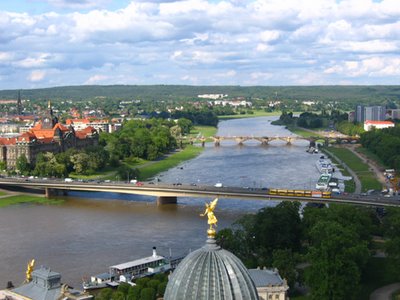

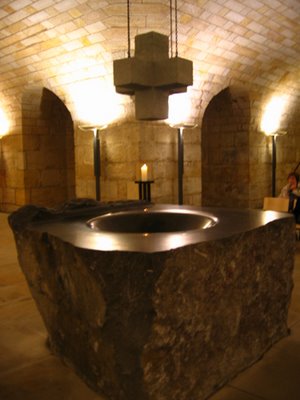
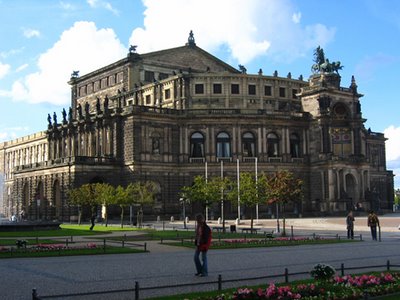 Or, “Opera Forever!” What a slogan; we had t-shirts printed last summer, for sale in our gift shop, which read “Life is Short / Opera is Long / Wagner is Forever”. The architect Gottfried Semper designed this opera house to match the nearby, Baroque, Zwinger Palace. The architectural style in which he was working was thus about a century old—and when the theater was restored, after the war, the style was more than two centuries old. No matter, it’s a dazzling building. Richard Wagner was Kappelmeister working for this company, but never in this building—it was built after he was exiled for playing a role in the Dresden uprising of 1849. (He had tried to get Semper to join the revolutionaries, too, but the architect knew better than to follow his common-sense-challenged composer friend. Later, Semper would work with Wagner to design a glorious new theater in Munich—a theater which was never built. I was also delighted to find the building where Wagner lived, right across from the Zwinger Palace, in luxury he couldn’t afford, amassing his famous Dresden library.
Or, “Opera Forever!” What a slogan; we had t-shirts printed last summer, for sale in our gift shop, which read “Life is Short / Opera is Long / Wagner is Forever”. The architect Gottfried Semper designed this opera house to match the nearby, Baroque, Zwinger Palace. The architectural style in which he was working was thus about a century old—and when the theater was restored, after the war, the style was more than two centuries old. No matter, it’s a dazzling building. Richard Wagner was Kappelmeister working for this company, but never in this building—it was built after he was exiled for playing a role in the Dresden uprising of 1849. (He had tried to get Semper to join the revolutionaries, too, but the architect knew better than to follow his common-sense-challenged composer friend. Later, Semper would work with Wagner to design a glorious new theater in Munich—a theater which was never built. I was also delighted to find the building where Wagner lived, right across from the Zwinger Palace, in luxury he couldn’t afford, amassing his famous Dresden library.

